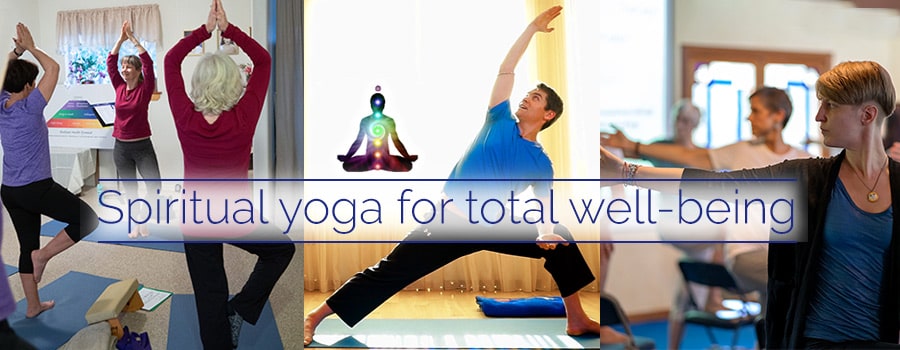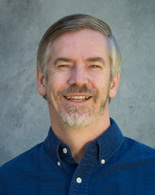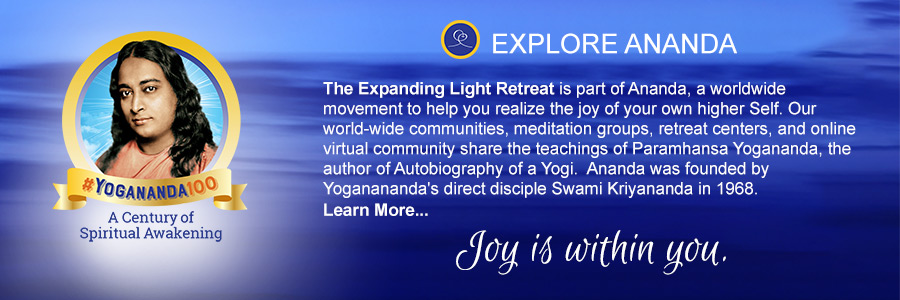Be Calmly Active and Actively Calm
|
This article was written for the Ananda Yoga® Teacher Association newsletter. Learn more, or find a certified Ananda Yoga® teacher near you. |
Many years ago I came across an intriguing quote from the great woman saint of India, Ananda Moyi Ma. Commenting on Hatha Yoga, she described it as “doing by force.”
At first I was quite taken aback, and definitely puzzled. Her description seemed to have very little to do with what I had presumed about Hatha Yoga — especially from the perspective of Ananda Yoga, since our emphasis is on relaxation, both as a primary focus and as a key tool.
The idea of “force” seemed to have no place at all in how I viewed Hatha Yoga. But I also knew that both Paramhansa Yogananda and Swami Kriyananda had great respect for this “Joy-Permeated Mother” as being a highly evolved yogi-saint. Trusting in that respect, I knew I had to dig deeper to mine the hidden gold in her message.
After searching some more, I came across other quotes from Ananda Moyi Ma that put the first quote into perspective and helped me understand her real point. She said, “Sustained effort ends in effortless being,“ and “One must enter into the rhythm of one’s own true nature.”
I realized that the “force” she was talking about was not that of compelling or “pushing” one’s body into a pose.
Rather, her emphasis was on the need to be actively engaged throughout the practice. Another way to put this is that we need to use will as an essential component in our practice in order for yoga — Self-realization — to become our reality. We cannot simply “slide downhill” into bliss. On the contrary, it takes all our dedicated energy to arrive at our goal in yoga: union with the Divine.
True Relaxation Takes Focus
This made me appreciate even more the similar emphasis that Paramhansa Yogananda gave to the practice of Yoga with his axiom, “The greater the will, the greater the flow of energy.” At the heart of his Energization Exercises is his admonition, “Tense with will, relax and feel.” In light of this and of my own practice of Hatha Yoga — as well as my experience of teaching others — I’ve come to a deeper understanding of what relaxation is and how we achieve it. Simply put, it requires dynamic focus!
The moment we become passive in relaxation — slipping into the subconscious and letting our minds wander in restless thoughts or drift into daydreaming — we actually diminish our level of relaxation.
This is why deep meditation, even though it requires great energy and focus, is so much more relaxing than sleep. In contrast to passivity, Yogananda stated that we as yogis should be “calmly active and actively calm,” meaning that we need to be centered in calmness while in the midst of activity, as well as dynamic in our calm and relaxed states.
Yogananda’s “tense with will, relax and feel” ties in beautifully with Ananda Moyi Ma’s “sustained effort ends in effortless being.” Together they guide us to a more fulfilling approach to hatha yoga. For example, let’s apply this to stretching in the asanas so we can see this as a practical application.
Using Will in Asana Practice
When we move into a pose, we use our “will” to open up and extend into the stretch; in effect this extension is “doing by force” or “tensing with will.” We’re engaging the body, but more significantly, we’re engaging the energy in the body, plus the mind, plus our awareness.But we don’t want to leave the emphasis solely on the extension; from this point we progress to relaxing into the pose. This is the “relax and feel” phase or, in Ananda Moyi Ma’s terms, it’s how we achieve “effortless being.”

“Divine calmness flows through me.”
It might be good to clarify that we’re not “hanging out” in this relaxing phase of the pose. Remember the words, “actively calm.” As we relax into the stretch, we want to engage in deep (ideally, diaphragmatic) breathing and keenly focus our awareness with the aid of mental affirmations, coming into the deepening stillness of asana. This is where we achieve the perfection of asana, regardless of how far we can stretch into the pose.
To come out of the pose we once again engage in extension and then flow into a resting, “neutral” pose before moving on to the next asana. The pauses between the different poses are more than just passive resting points in our routine. They’re really an integral part of the deeper aspect of yoga since they give us the space to assimilate our experiences of the asanas. And, more importantly, they help us to dive more deeply into the superconscious.
Finding a Higher Rhythm
Again, in my own practice of hatha yoga, I’ve come to understand and value the importance of Ananda Moyi Ma’s quote, “One must enter into the rhythm of one’s own true nature.” This inner connection shifts yoga from something we “do” to something we “are.” Yoga is the unfolding into who we really are, not the creating or adding on to who we are.
When we truly engage in yoga by actively tuning in to the energy flow within us — whether stretching in an asana, walking down a street, sipping a cup of tea, or talking with someone — we open up to our inner qualities of joy, love, peace, calmness, power and wisdom. And these qualities, which are the rhythm of our own true nature, become more manifest in every moment of our lives.
Related Articles
All authors are graduates of Ananda Yoga Teacher Training.





















